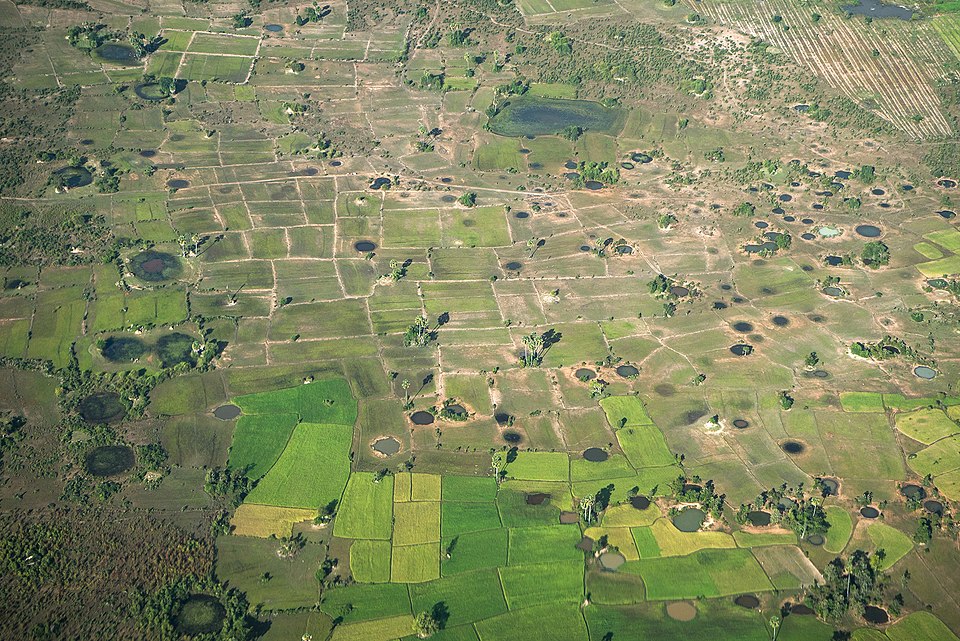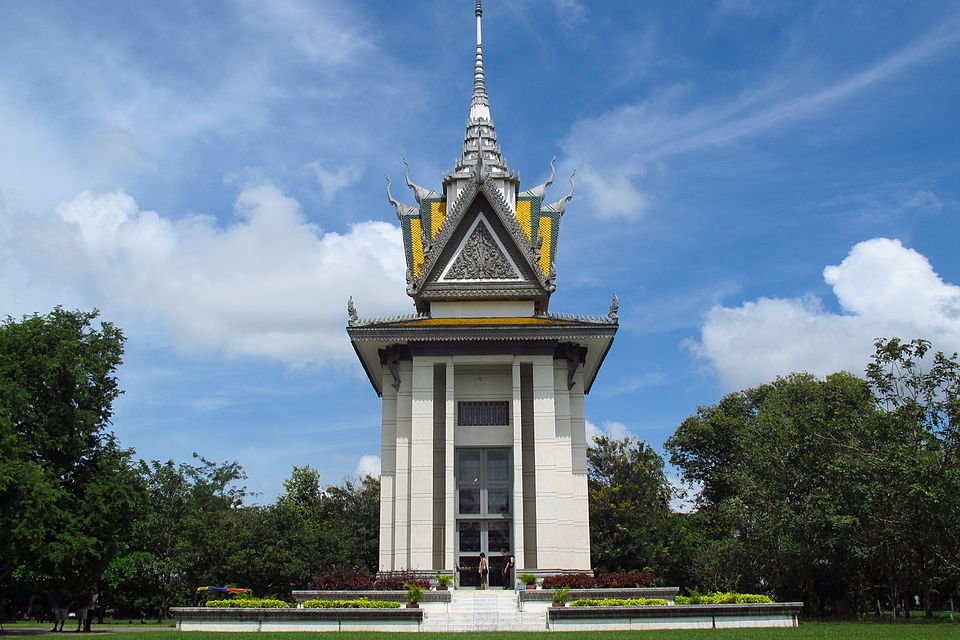OCR Specification focus:
‘US bombing and the fall of the Khmer republic 1970–1975; Pol Pot and Democratic Kampuchea (the Khmer Rouge 1975–1978, Chinese Models, evacuation to the rural areas, anti-intellectualism, the Killing Fields’
The United States’ intervention in Cambodia and the rise of the Khmer Rouge reshaped the Cold War in Southeast Asia, with devastating social, political, and human consequences.
The US Bombing Campaign in Cambodia, 1969–1973
Background to US Policy
Cambodia was drawn into the Vietnam War despite initially trying to remain neutral under Prince Norodom Sihanouk. The US justified military action on the grounds that North Vietnamese forces were using sanctuaries along the Ho Chi Minh Trail inside Cambodia to support operations in South Vietnam. President Richard Nixon authorised extensive bombing campaigns.
Operation Menu and Subsequent Campaigns
Operation Menu (1969–1970): secret B-52 carpet bombing raids targeting supposed Vietcong and North Vietnamese bases.
Operation Freedom Deal (1970–1973): widened bombing, covering much of Cambodia’s countryside.

Aerial view of extensive bomb craters in Kandal Province, a heavily targeted rural area during US bombing of Cambodia in 1969–1973. The pockmarked fields show typical patterns from B-52 carpet bombing. Source
Casualties are difficult to measure, but estimates suggest tens of thousands of civilians were killed.
The bombing destabilised rural Cambodia, leading many peasants to support radical alternatives.
Impact of US Intervention
Destroyed infrastructure and worsened food insecurity.
Radicalised rural communities, undermining the Cambodian government.
Provided propaganda for the Khmer Rouge, who portrayed themselves as defenders of the nation against American aggression.
The Fall of the Khmer Republic, 1970–1975
Establishment of the Khmer Republic
In 1970, General Lon Nol, supported by the US, overthrew Sihanouk and established the Khmer Republic. His regime aligned itself with Washington, but it was weak, corrupt, and unpopular.
Struggles of the Khmer Republic
Dependent on American aid and military support.
Unable to control the countryside effectively, leaving space for the Khmer Rouge insurgency to grow.
By 1975, the Khmer Rouge controlled most of Cambodia.
On 17 April 1975, the capital Phnom Penh fell, marking the collapse of the Khmer Republic.
The Rise of Democratic Kampuchea under Pol Pot
Pol Pot and the Khmer Rouge
Pol Pot (real name Saloth Sar) became the leader of Democratic Kampuchea (1975–1979). His vision was to create a self-sufficient, classless, agrarian society by purging Cambodia of perceived enemies and external influences.
Democratic Kampuchea: The official name of Cambodia under Khmer Rouge rule from 1975 to 1979, characterised by radical agrarian socialism and mass killings.
Influence of Chinese Models
Pol Pot admired Maoist China and borrowed heavily from the Cultural Revolution.
Policies included mass collectivisation, self-reliance, and the eradication of foreign and capitalist elements.
However, the Khmer Rouge applied these principles even more harshly and rapidly than China had.
Social and Political Policies of the Khmer Rouge
Evacuation to the Countryside
Immediately after taking Phnom Penh, the Khmer Rouge forcibly evacuated cities.
The rationale: eliminate class divisions and create a peasant-based society.
Urban populations, including professionals, students, and former officials, were subjected to forced agricultural work.
Anti-Intellectualism
The Khmer Rouge pursued an extreme form of anti-intellectualism.
Teachers, doctors, lawyers, and those who spoke foreign languages were targeted as enemies of the revolution.
Even wearing glasses was sometimes seen as a sign of intellectualism and grounds for execution.
Anti-intellectualism: Hostility towards educated individuals and institutions, often based on the belief that they threaten ideological purity or revolutionary goals.
Social Reorganisation
Traditional family structures were dismantled; children were separated from parents and indoctrinated in collective groups.
Religion was banned, and Buddhist monks were executed or forced into labour.
Money, markets, and private property were abolished.
The Killing Fields
Scale of Violence
The Khmer Rouge established a network of prisons and execution sites, the most infamous being Tuol Sleng (S-21) in Phnom Penh. Prisoners were tortured into confessing crimes before execution.
Mass graves, later known as the Killing Fields, were created across Cambodia.

The memorial stupa at Choeung Ek near Phnom Penh contains the remains of thousands of victims executed by the Khmer Rouge between 1975 and 1979. The site represents one of the most documented Killing Fields linked to S-21 prisoner transfers. Source
Between 1.5 and 2 million people (approximately a quarter of Cambodia’s population) died from executions, starvation, overwork, and disease.
Internal Purges
The regime killed not only perceived external enemies but also many of its own members suspected of disloyalty.
This created an atmosphere of fear and paranoia that permeated the state.
Collapse of Democratic Kampuchea
By the late 1970s, Cambodia was economically devastated and socially fractured. Growing tensions with Vietnam led to war, and in 1979, a Vietnamese invasion overthrew the Khmer Rouge, bringing an end to Pol Pot’s Democratic Kampuchea. However, the legacy of destruction left profound consequences for Cambodia and the wider Cold War balance in Southeast Asia.
FAQ
Although ousted in 1970 by Lon Nol, Sihanouk became an unlikely ally of the Khmer Rouge. From exile in Beijing, he publicly supported them, which gave the movement legitimacy in the eyes of many Cambodians loyal to the monarchy. His backing encouraged peasants to side with the Khmer Rouge against Lon Nol’s unpopular regime, strengthening their influence in the countryside.
Traditional Cambodian farming relied on small family plots and seasonal rice production, with strong village autonomy.
The Khmer Rouge abolished private plots and enforced collective farming.
Families were broken up and labour was organised into work brigades.
Ambitious schemes, such as large-scale irrigation projects, were attempted without proper planning.
Rice quotas were often impossibly high, leading to famine and widespread malnutrition.
Pol Pot’s vision of a homogenous, self-sufficient society meant that ethnic minorities were seen as obstacles.
The Cham Muslim community was forced to abandon religious practices and assimilate.
Vietnamese and Chinese minorities faced persecution, expulsions, or killings.
These policies reflected the regime’s paranoia about foreign influence and desire to eliminate cultural diversity.
Tuol Sleng was a former school turned into a notorious prison. Detainees were often accused of being spies or traitors, reflecting the regime’s obsession with rooting out “enemies within.”
Conditions included:
Brutal interrogations to force false confessions.
Systematic documentation of prisoners and their supposed crimes.
Execution after confessions, with families of prisoners often also killed.
This demonstrated the regime’s climate of fear, control, and purges even among its own supporters.
After Vietnam toppled the Khmer Rouge in 1979, journalists and NGOs documented mass graves across Cambodia, shocking global audiences.
Western governments condemned the atrocities, though Cold War politics complicated direct involvement.
Human rights groups and the UN highlighted the crimes as evidence of genocide.
The memorialisation of sites like Choeung Ek became symbols of international awareness of mass violence and the need for justice.
Practice Questions
Question 1 (2 marks):
Name one policy introduced by the Khmer Rouge immediately after taking Phnom Penh in April 1975.
Mark Scheme:
1 mark for correctly identifying a relevant policy.
2 marks for a more precise answer (date/context or clear description).
Examples:Forcible evacuation of urban populations to the countryside (2 marks if given with clear detail such as “April 1975 evacuation of Phnom Penh”).
Abolition of money and markets.
Abolition of religion or persecution of Buddhist monks.
Collective labour enforced on agricultural communes.
Question 2 (6 marks):
Explain two ways in which US bombing campaigns in Cambodia between 1969 and 1973 contributed to the rise of the Khmer Rouge.
Mark Scheme:
Award up to 3 marks per explanation.
1 mark for a general statement.
2 marks for development with accurate detail.
3 marks for developed explanation that links clearly to the Khmer Rouge’s rise.
Indicative content:
Civilian casualties and destruction of rural communities: Bombing caused large-scale loss of life and displacement, fuelling resentment towards the US-backed Khmer Republic and encouraging recruitment to the Khmer Rouge. (up to 3 marks)
Use as propaganda: The Khmer Rouge exploited anger at US intervention by presenting themselves as defenders of Cambodian peasants, which increased their support base. (up to 3 marks)
Destabilisation of Lon Nol’s regime: Bombing undermined the government’s legitimacy and created instability, making it easier for the Khmer Rouge to expand their control. (alternative valid explanation, up to 3 marks)

